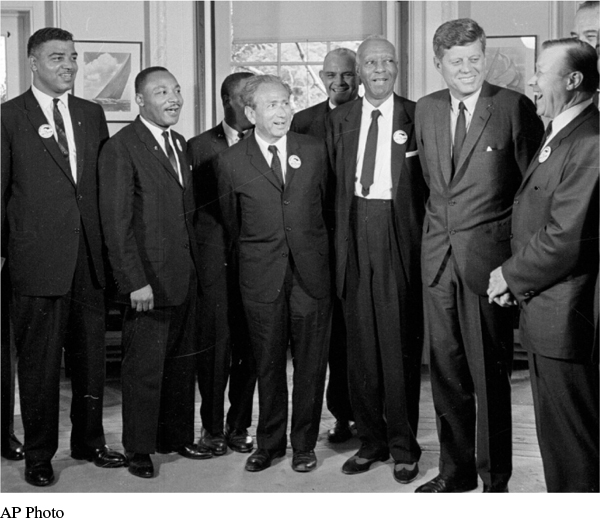Kennedy Supports Civil Rights
Despite the setback in Albany, the civil rights movement kept up pressure on other fronts. In September 1962 Mississippi governor Ross Barnett tried to thwart the registration of James Meredith as an undergraduate at the University of Mississippi. Barnett’s obstruction precipitated a riot on campus, and President Kennedy dispatched army troops and federalized the Mississippi National Guard to restore order, but not before two bystanders were killed.
The following year, King and the SCLC joined the Reverend Fred Shuttlesworth’s movement in Birmingham, Alabama, in its battle against discrimination, segregation, and police brutality. With the white supremacist Eugene “Bull” Connor in charge of law enforcement, civil rights protesters, including children from age six to sixteen, encountered violent resistance, vicious police dogs, and high-powered water hoses. Connor ordered mass arrests, including Dr. King’s, prompting the minister to write his famous “Letter from Birmingham Jail,” in which he justified the use of nonviolent direct action. Seeking to defuse the crisis, President Kennedy sent an emissary in early May 1963 to negotiate a peaceful solution that granted concessions to Birmingham blacks and ended the demonstrations. On Sunday, September 15, 1963, however, the Ku Klux Klan dynamited Birmingham’s Sixteenth Street Baptist Church, a freedom movement staging ground. The blast killed four young girls attending services.
Even before this brutal bombing, the president had finally embraced the nation’s duty to guarantee equal rights regardless of race. On June 11, 1963, shortly after negotiating the Birmingham agreement, Kennedy delivered a nationally televised address. He acknowledged that the country faced a “moral crisis” heightened by the events in Birmingham, and he noted the difficulty of preaching “freedom around the world” while “this is a land of the free except for Negroes.” He proposed congressional legislation to end segregation in public accommodations, increase federal power to promote school desegregation, and broaden the right to vote.
Events on the day Kennedy delivered his powerful speech reinforced the need for swift action. Earlier that morning, Alabama governor George C. Wallace stood in front of the administration building at the University of Alabama to block the entrance of two black undergraduates. To uphold the federal court decree ordering their admission, Kennedy deployed federal marshals and the Alabama National Guard, and Wallace, having dramatized his point, stepped aside. However, victory soon turned into tragedy. That evening Medgar Evers, the head of the NAACP in Mississippi, was shot and killed in the driveway of his Jackson home by the white supremacist Byron de la Beckwith. (Following two trials, de la Beckwith remained free until 1994, when he was retried and convicted for Evers’s murder.)
Nonetheless, Congress was still unwilling to act. To increase pressure on lawmakers, civil rights organizations held the March on Washington for Jobs and Freedom on August 28, 1963, carrying out an idea first proposed by A. Philip Randolph in 1941 (see “The Origins of the Civil Rights Movement” in chapter 23). With Randolph as honorary chair, his associate Bayard Rustin directed the proceedings as 250,000 black and white peaceful protesters rallied in front of the Lincoln Memorial. Two speakers in particular caught the attention of the crowd. John Lewis, the chairman of SNCC, expressed the frustration of militant blacks with both the Kennedy administration and Congress. “The revolution is at hand. . . . We will not wait for the President, nor the Justice Department, nor Congress,” Lewis asserted. “But we will take matters into our own hands.” In a more conciliatory tone, King delivered a speech expressing his dream for racial and religious brotherhood. Still, King issued a stern warning to “those who hope that the Negro needed to blow off steam and will now be content. . . . There will be neither rest nor tranquility in America until the Negro is granted his citizenship rights.”

If civil rights leaders hoped to elicit additional support from the Kennedy administration, their hopes were dashed. On November 22, 1963, Lee Harvey Oswald shot President Kennedy as he rode in an open motorcade in Dallas, Texas. The assassination prompted an outpouring of public grief. In death, Kennedy achieved immense popularity, yet he left many problems unresolved. His legislative agenda, including civil rights, remained unfulfilled. It was up to Vice President Lyndon Johnson to step into the breach.
Exploring American HistoriesPrinted Page 863
Exploring American Histories Value EditionPrinted Page 637
Chapter Timeline